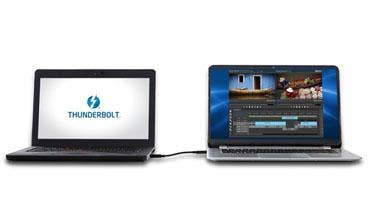Thunderbolt 2 Offers Peer-to-Peer Networking

With the Intel announcement at NAB 2014 this week that Thunderbolt 2 will support peer-to-peer networking, there's yet another reason for hardware makers to embrace the versatile specification that's currently connecting computers to 4K and QHD monitors and high-speed storage. Thunderbolt 2 also makes good on Intel's promise to double the bandwidth of a single channel to 20 Gbps; Thunderbolt 1 supports two channels of 10 Gbps each.
Dubbed Thunderbolt Networking, the spec permits two Thunderbolt-equipped computers to connect for file transfer, backup, upgrades and other communications and workflows using a standard Thunderbolt cable. Thunderbolt Networking works by emulating a 10GbE Ethernet connection between two PCs, two Macs or between a PC and a Mac, in theory at least. Drivers for Mac-to-Mac connections are provided in Apple's latest OS X Mavericks, but drivers for Windows and cross-platform connections are still being developed.
The 20-Gbps transfer rate makes Thunderbolt 2 king of the performance hill. Its next closest rival -- USB 3.0 -- is a distant second with a rate of 5 Gbps. But greater performance doesn't always make the sale. Just look at FireWire, which failed to gain wide adoption in desktop systems despite its vast performance superiority at the time of its release.
We believe that Thunderbolt's ace in the hole will be the coming of ultra-HD monitors, also known as 4K for a horizontal resolution that approaches 4,000 pixels. Such monitors have enjoyed significant market growth since Intel's last Thunderbolt refresh about a year ago. According to a March report by researcher NDP DisplaySearch, about 1.6 million 4K monitors were shipped in 2013, with close to 1 million in the fourth quarter alone. The market is expected to reach 7 million units by 2016.
Thunderbolt supports the connection of monitors via DisplayPort 1.2, a 20-pin, hot-pluggable spec that itself is fairly versatile. In addition to video and up to 8 channels of 24-bit audio, DisplayPort carries USB and several other forms of data at up to 17.28 Gbps. That's good enough for resolutions of around 3,840-x-2,160, plus 3-D and chaining of as many as three compatible monitors from a single connection. Older Thunderbolt cables are compatible with the new spec. DisplayPort 1.3, expected this year, will double bandwidth to 32.4 Gbps, which in turn will increase resolution support to 8,192-to-4,320 pixels and permit two 4K streams or a single 3D 4K stream over a single cable.
PUBLISHED APRIL 8, 2014